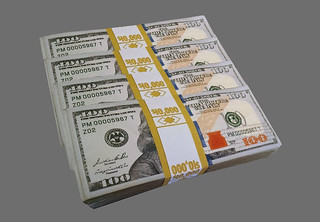
PREV ARTICLE
NEXT ARTICLE
FULL ISSUE
PREV FULL ISSUE
PROP MONEY PODCASTKavan Ratnatunga passed along a link to an interesting 2017 podcast on prop money. Thanks. Here's an excerpt. It's very well done and has links to several movie clips where prop money is used. Check it out! -Editor
A company named ISS Props had provided the money for that scene (and several others) to the filmmakers. The fake money amounted to nearly a billion dollars in fake bills — and the company was surprised when one day, during the filming, two men from the Secret Service showed up to their office. The Secret Service was there because some of the fake cash had gone missing from the set and had started turning up on the Las Vegas strip. CEO of ISS Props, Gregg Bilson Jr., was now facing a serious charge: counterfeiting. The U.S. has strict penalties for counterfeiting that can be traced back to the 1860s. Around the time of the Civil War, there was a lot of counterfeit money circulating through the country. The federal government needed to assure faith in its currency, so it got serious about cracking down on counterfeit bills. All reproductions of U.S currency became illegal, including photographs of money. In 1865, a new enforcement agency was formed to help deal with the counterfeiting problem: the Secret Service. That agency is now part of the Department of Homeland Security and is generally associated with protecting leaders and their families. But in the beginning, they were part of the Treasury Department, and their only job was to fight counterfeiting. The ban on any photographic representation of money was in place for about a century, and this created a problem for people who worked in visual media, which came to include film. In the early days of cinema, when money was needed in a film, producers often used Mexican pesos. After the Mexican revolution ended (around 1920), a bunch of regional Mexican money that had been created during the revolution lost value and was sold for cheap. In the second half of the 20th century, the government began relaxing restrictions on the rules around photographing currency and it’s now legal to show real money in film. Using real money is great for scenes where you only need to show a small amount in a close-up shot. But for scenes where you need a lot of visible cash, it can be too risky. For those kinds of scenes, fake money is often preferred. Gregg Bilson’s bills for Rush Hour 2 featured many small differences setting them apart from the real things, but they were still too close to reality for the Secret Service. Bilson had to turn over all of this prop money to be destroyed. They also confiscated and destroyed all the electronic files used in creating the fake money. To read the complete article and listen to the podcast, see: Wayne Homren, Editor The Numismatic Bibliomania Society is a non-profit organization promoting numismatic literature. See our web site at coinbooks.org. To submit items for publication in The E-Sylum, write to the Editor at this address: whomren@gmail.com To subscribe go to: https://my.binhost.com/lists/listinfo/esylum All Rights Reserved. NBS Home Page Contact the NBS webmaster 
|
